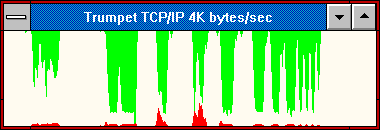
TCPmeter will show speed as a fraction of the vertical scale (height of its window, which you may adjust for pleasing display.) The TCPmeter window's title bar will show its vertical full-scale amount, which may be increased by clicking your left mouse button anywhere in that window, and decreased by clicking the right button.

Data rate received by your machine will be shown as a green trace, with zero at the top of the window and full-scale at the bottom (like stalactites), while data rate sent by your machine will show as a red trace with zero at the bottom (like stalagmites).
The 2.1 version makes an .ini file in your windows directory to remember your last window size, placement and scale setting.
TCPMeter is not very useful in tuning your TCP settings (MSS/RWIN) or your IP MTU, but is a low-overhead way of monitoring how well the Internet (and your access provider) are feeding your well-tuned connection.
The best single tool for tuning TCP/IP settings is Trumpet WinSock's built-in TCP Trace. Once tuned, if you get slow response from a requested TCP sender, turn on TCP Meter and try to use the difference between the rate at which you should be able to download (3.2 KBytes/sec for a 28.8 Kbps connection, or 1.6 KBytes/sec for a 14.4) and the rate you're seeing for a simultaneous download from another site by opening a second download socket.
If you see a higher total rate on TCP Meter, you know the problem is a busy remote site (or intermediary IP router in that path). If you don't, you might ask your access provider when he's going to upgrade his Internet access bandwidth to keep up with the load his customer base is generating ;-).
This FAQ is available as a Windows Help® file for off-line viewing
Copyright© 1995 by Albert P. Belle Isle